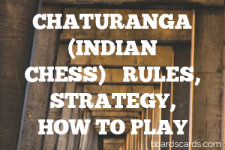Go: Mastering the Ancient Game – Rules, Winning Strategies, and How to Play Guide
Introduction
Go is an ancient board game that originated in China over 2,500 years ago as a game of strategy and wit. Two players take turns placing stones on a grid, with the aim of controlling more territory than their opponent. I find the game is simple to learn, yet very complex to master and play at a high level, making it a fascinating and challenging pastime for people of all ages.

The game of Go is played on a board with a grid of 19×19 lines, although smaller boards of 13×13 or 9×9 lines are also used for quicker games. Each player has a set of stones, one playing with black stones and the other with white. The game begins with an empty board, and players take turns placing their stones on the intersections of the grid lines.
Go has had a significant cultural impact throughout Asia’s history. Its influence can be seen in various aspects of society, particularly in East Asian cultures. In the past, it was considered one of the four essential arts of a cultured Chinese scholar.
It has been cited in various literary works and has been used as a tool to teach strategic thinking and Taoist philosophy. Go also holds a strong place in Japanese, Korean, and Taiwanese cultures where professional Go players often have celebrity status.
In recent years, Go has gained global recognition due to the development of artificial intelligence (AI). The game between the world champion, Lee Sedol, and Google’s AI, AlphaGo, in 2016 demonstrated the advancement of AI technology and sparked worldwide interest in the game.
Moreover, Go has influenced various forms of popular culture, including movies, TV shows, and books. Overall, the game of Go has not only provided entertainment but has also affected different cultural, educational, and technological facets of society. It is one of the national games of Japan, along with Shogi (Japanese Chess), which I’ve also written a guide on.
Rules for playing Go
- The game begins with an empty board. Players take turns placing their stones on the intersections of the grid lines.
- A stone once placed cannot be moved unless it is captured by the opponent.
- A stone or group of stones is captured and removed from the board when all the intersections directly adjacent to it are occupied by enemy stones.
- The game ends when both players agree that there are no more useful moves left. This usually happens when all the territories have been claimed and all the battles have been resolved.
- The player who controls more territory at the end of the game wins.
These are the basic rules of Go, but there are many more subtle rules and strategies that can be learned as you gain experience with the game.
How do you play Go
Setup
The game of Go starts with an empty board. The player with the black stones goes first, placing a stone on any intersection of the grid lines. The players then alternate turns, placing their stones on the board.
Gameplay
During their turn, a player may place a stone on any vacant intersection. The aim is to use your stones to form territories by surrounding vacant areas of the board. At the same time, you must try to prevent your opponent from doing the same.
End of the Game
The game ends when both players agree that there are no more useful moves left. The territories are then counted, and the player with the most territory wins.
How to Win at Go
Winning at Go requires a combination of strategy, tactics, and observation. Here are some tips to help you improve your game:
- Focus on the corners and sides of the board first. It’s easier to build secure territories in these areas.
- Try to keep your stones connected. A group of stones working together is much stronger than individual stones.
- Don’t get into unnecessary fights. It’s often better to concede a small piece of territory than to start a fight that you can’t win.
- Stay flexible. The situation on the board can change rapidly, so be ready to adjust your strategy as needed.
Best Strategies for playing Go game
Go is a game of balance and strategy. Here are some strategies that can help you win:
- Control the center: The center of the board is important for influence and potential territory. Controlling the center can give you more options for expanding your territory.
- Use efficient shapes: Certain patterns of stones are more efficient and stronger than others. Learning these shapes can help you build stronger positions.
- Attack and defend: You need to balance attack and defense. If you focus too much on attack, you may leave your own territory vulnerable. If you focus too much on defense, you may miss opportunities to gain territory.
- Endgame strategy: The endgame is crucial in Go. Even a few points can make the difference between winning and losing. Make sure to count carefully and play the biggest moves first.
Scenarios for Go
There are countless scenarios that can arise in a game of Go, each with its own challenges and opportunities. Here are a few common scenarios and how to handle them:
- Invading enemy territory: If your opponent has a large territory, you may need to invade to reduce it. This is risky, but can be very rewarding if successful.
- Defending your territory: If your opponent invades your territory, you need to defend effectively. Try to surround the invading stones and capture them.
- Fighting a ko: A ko is a special kind of fight that can occur in Go. It’s a complex situation that requires careful strategy and timing to resolve.
- Playing the endgame: In the endgame, every point counts. You need to play carefully and efficiently to maximize your score.
Frequently Asked Questions about playing Go game
- How long does a game of Go usually last?
A game of Go can last anywhere from 20 minutes to several hours, depending on the size of the board and the speed of the players. - Is Go a game of luck or skill?
Go is a game of skill. While there is some luck involved in the initial placement of the stones, the outcome of the game is largely determined by the players’ strategy and tactics. - Can Go be played by more than two players?
Go is traditionally a two-player game, but there are variants that allow for more players. - Is Go similar to chess?
While Go and chess are both strategic board games, they are quite different in terms of gameplay and strategy. Go is more about territory control, while chess is about capturing the opponent’s king. - Can I learn to play Go online?
Yes, there are many online resources and apps where you can learn to play Go and practice your skills.
External Links
For more information about Go, visit the official game website here.

A digital native around since the early days of online gaming communities around 2001. An early contributor to the cult gaming site ClanTemplates, Adam has spent years giving free gaming resources to the community. With BoardCards, Adam is most experienced and commonly writing the articles on Strategy multi-player games like Settlers of Catan and Avalon. His first introduction to board games was via Mancala, an Egyptian-origin stone game and one of the oldest known games still played worldwide. Contact me via email



